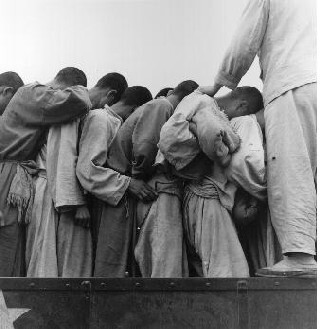hankyoreh
Links to other country sites 다른 나라 사이트 링크
Truth commission confirms Korean War killings by soldiers and police

South Korea’s Truth and Reconciliation Commission announced Monday that it had confirmed that at least 3,400 civilians and inmates incarcerated at prisons in Busan, Masan and Jinju were illegally victimized by soldiers and police from July to September of 1950. This marks the first time a state institution has formally confirmed suspicions that officers of the military and police retreating immediately after the outbreak of the Korean War engaged in the indiscriminate killing of prison inmates.
According to the TRC’s research results, at least 1,500 inmates and members of the Bodo League (National Guidance Alliance) were killed en masse by prison guards and regional police officers, including members of the Counterintelligence Corps for the Busan region, in three sets of attacks between July 26 and Sept. 25, 1950. The victims were taken away after the war broke out, on the pretext of being transferred to another prison. Some were shot dead en masse at places like Dongmae-san in Busan’s Saha-gu and the Jang-san ravine in Haeundae-gu, while others were drowned in the sea near Busan’s Oryuk Island.
At roughly the same time, at least 717 inmates at Masan Prison and members of the Bodo League were shot dead or thrown into the sea off of Masan’s Gusan-myeon. At least 1,200 victims were killed by similar methods at Jinju Prison. Among them, a total of 576 have had their identities confirmed by the TRC.
“It may have been wartime, but it was a criminal act to illegally execute prison inmates and civilian members of the National Guidance Alliance in the Busan and South Gyeongsang Province regions, noncombatant regions under the control of the Republic of Korea, simply out of concerns that they might cooperate with the People’s Army advancing southward,” said a representative of the TRC.
“Most of the inmates were not death penalty cases but were prisoners with short sentences of less than three years for acts like violating the army’s criminal code,” a representative of the commission explained. “Executing convicted prisoners with established sentences in such a way was a violation of the rule prohibiting double jeopardy as specified in the Constitution,” the representative said.
The TRC representative also stated, “Among the inmates, some convicted prisoners were sentenced to death at a court-martial, transferred to the military police and shot, but the court-martial was a formality, and it was effectively no different from a mass execution.”
Following these results, the TRC recommended to the state that it apologize to the surviving family members, support memorial activities, reflect the sacrifice of civilians in its formal publications, and strengthen human rights education.
The TRC has been conducting an official investigation of the “prison victimization incident” since November 2006, and this year it is expected to release the results of its investigation on nationwide prisons at the time, including those in Daejeon, Gwangju and Daegu.
Please direct questions or comments to [englishhani@hani.co.kr]
Editorial・opinion
![[Column] Season 2 of special prosecutor probe may be coming to Korea soon [Column] Season 2 of special prosecutor probe may be coming to Korea soon](https://flexible.img.hani.co.kr/flexible/normal/500/300/imgdb/original/2024/0426/3317141030699447.jpg) [Column] Season 2 of special prosecutor probe may be coming to Korea soon
[Column] Season 2 of special prosecutor probe may be coming to Korea soon![[Column] Park Geun-hye déjà vu in Yoon Suk-yeol [Column] Park Geun-hye déjà vu in Yoon Suk-yeol](https://flexible.img.hani.co.kr/flexible/normal/500/300/imgdb/original/2024/0424/651713945113788.jpg) [Column] Park Geun-hye déjà vu in Yoon Suk-yeol
[Column] Park Geun-hye déjà vu in Yoon Suk-yeol- [Editorial] New weight of N. Korea’s nuclear threats makes dialogue all the more urgent
- [Guest essay] The real reason Korea’s new right wants to dub Rhee a founding father
- [Column] ‘Choson’: Is it time we start referring to N. Korea in its own terms?
- [Editorial] Japan’s rewriting of history with Korea has gone too far
- [Column] The president’s questionable capacity for dialogue
- [Column] Are chaebol firms just pizza pies for families to divvy up as they please?
- [Column] Has Korea, too, crossed the Rubicon on China?
- [Correspondent’s column] In Japan’s alliance with US, echoes of its past alliances with UK
Most viewed articles
- 1‘We must say no’: Seoul defense chief on Korean, USFK involvement in hypothetical Taiwan crisis
- 2[Editorial] Korea’s surprise Q1 growth requires objective assessment, not blind fanfare
- 3[Column] Season 2 of special prosecutor probe may be coming to Korea soon
- 4Division commander ordered troops to enter raging flood waters before Marine died, survivor says
- 5Is Japan about to snatch control of Line messenger from Korea’s Naver?
- 6The dream K-drama boyfriend stealing hearts and screens in Japan
- 7[Column] ‘Choson’: Is it time we start referring to N. Korea in its own terms?
- 8No good, very bad game for Korea puts it out of Olympics for first time since 1988
- 9[Special report- Part III] Curses, verbal abuse, and impossible quotas
- 10S. Korea “monitoring developments” after report of secret Chinese police station in Seoul